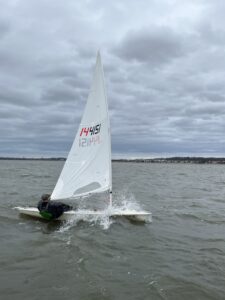Happy late Thanksgiving everyone!! It was wonderful to have our first foul weather frostbite of the year. Ten sailors braved ~40-degree weather, off-and-on rain, and 10-20 mph wind. Congrats to Kaitlyn, Tom, and Tyler for winning today’s six races.
Today’s courses tended to have long starboard tacks, which was unfortunate for me – I accidentally brought two left gloves out with me and had to spend several minutes fighting to keep my mainsail sheeted in with a backwards glove on my right hand. This also meant that most of the passes took place at the marks, so boathandling during roundings was at a premium. In medium-heavy air, it’s crucial to ease the vang on approach to the windward mark and use your body weight to turn the boat. These actions relieve weather helm and help turn the boat more efficiently. Tom and Tyler seemed to a particularly good job of cleanly rounding the weather mark and getting a good jump on the downwinds. At the leeward mark, it was important to preset your controls for the upwind and doing a wide and tight rounding. I passed more than a few people today by making sure I was on the correct (port) gybe approaching the mark and going wide-and-tight around the mark to make sure I got inside position. Every time I messed this up, I got passed.
After the races, I had a brief conversation with Tyler about heavy wind downwinds. The first thing I told him is that I prefer to reach, rather than sail by the lee in breeze over 12 mph. It helps keep the boat upright, makes pumping and planing easier, and allows for more maneuverability on short notice. We also discussed body position in the cockpit. As a rule of thumb, you want to be at the front of the cockpit in a Laser any time the hull is not planing. On lighter downwinds, I try to have by center of mass even with the daggerboard. Having weight further forward in the boat lifts the largest surface on your hull (the stern) out of the water to reduce drag. In heavier breeze, I try to move back to the widest part of the hull to use my weight to more effectively prevent death rolls.
Thanks to Brian Joseph and his daughter for setting excellent courses and taking care of us on the water. They did an excellent job of setting up pin-favored lines, which made for more tactically interesting starts and fewer clumps at the boat end of the line. See y’all next week.
-Connor


